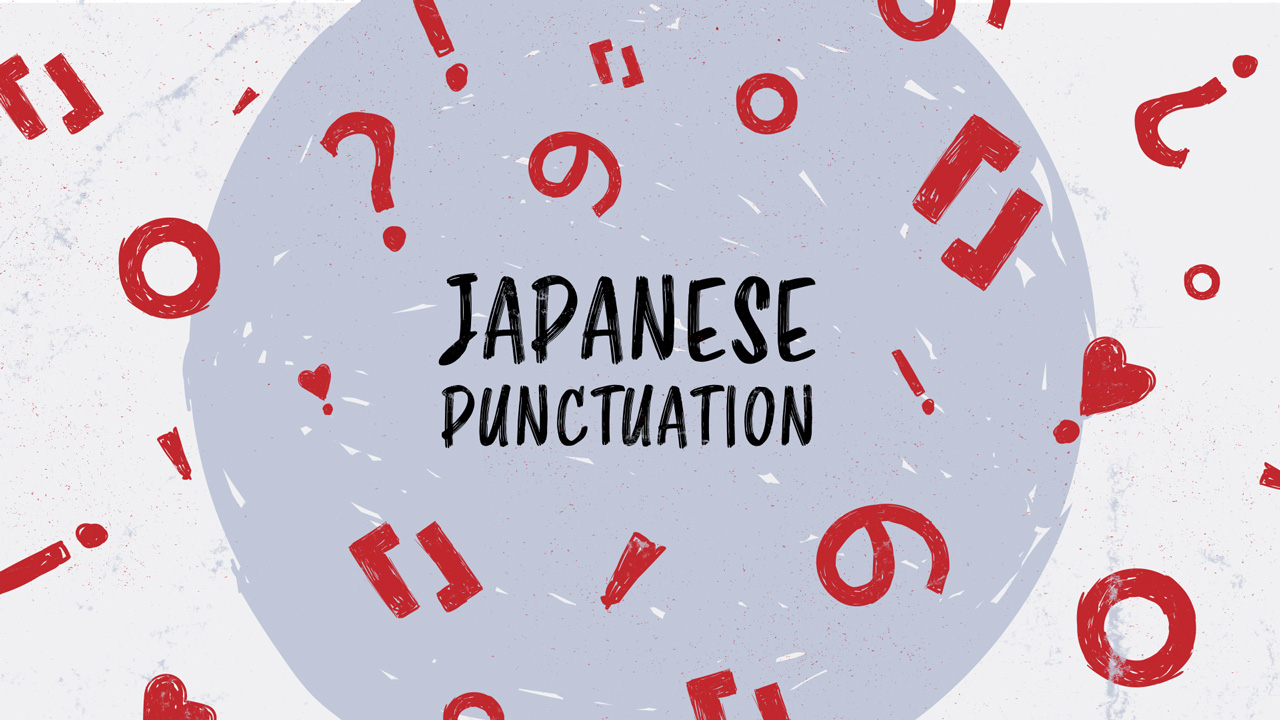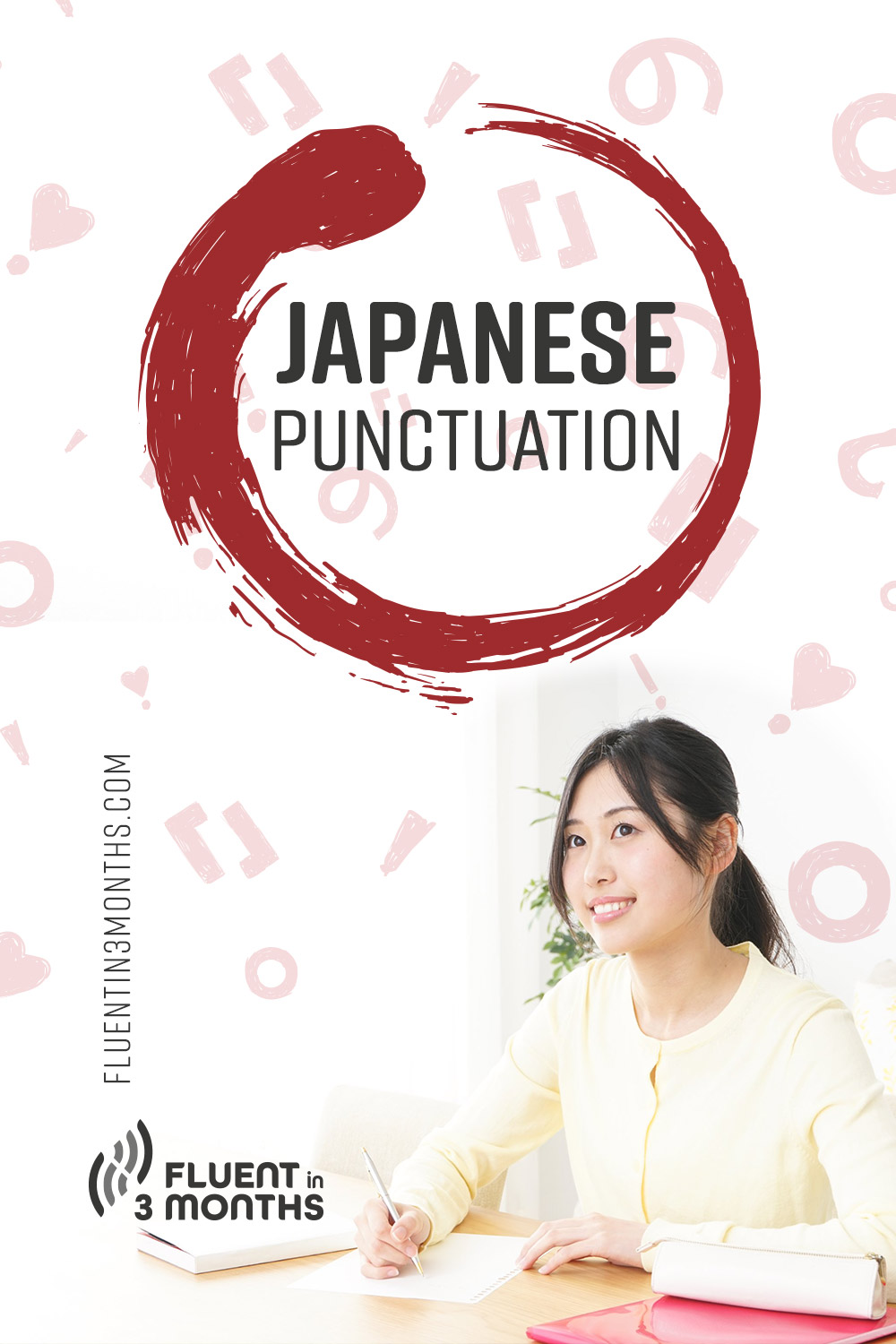Japanese Punctuation: Everything You Need to Know
Why are there so many types of punctuation in Japanese?! While there are similarities between Japanese and English, Japanese punctuation definitely has some unique features.
If you’ve ever used a Japanese keyboard, you’ll have seen an endless amount of Japanese punctuation marks compared to the 14 options in English.
Table of contents
- Japanese Punctuation: 約物 (yakumono)
- Japanese Period Punctuation: 句点 (kuten)、まる (maru)
- Japanese Quotation Marks: 鍵括弧 (kagikakko) and 二重鍵括弧 (nijukagikakko)
- Japanese Comma: 読点 (touten), 点 (ten)
- Japanese Question Mark: か (ka), 疑問符 (gimonfu), はてなマーク (hatena ma-ku)
- Japanese Exclamation Point: 感嘆符 (kantanfu) or ビックリマーク (bikkuri ma-ku)
- Japanese Parenthesis: 括弧 (kakko)
- Japanese Possessive Punctuation: の (no)
- The Japanese Interpunct: 中黒 (nakaguro)
- The Japanese Wave Dash: 波ダッシュ (nami dasshu)
- Japanese Ellipses: 三点リーダー (santenri-da-)
- More Punctuation and Kana Phonetic Marks
- Japanese Letter Spacing
- Japanese Punctuation Alt Codes
- Don’t Forget Your Japanese Punctuation!
Japanese Punctuation: 約物 (yakumono)
You may even have questioned, “Does Japanese use punctuation?” at all because it’s traditionally written vertically.
Some of those marks adapt to the writing style – horizontal or vertical. But this is a fair question because Japanese didn’t always have punctuation.
If you look at Japanese history and its impact on the language, you’ll find that the Meiji period introduced modern punctuation. Emperor Meiji was a great lover of the arts and literature, and these fields flourished during this time. His love of Western culture and books is what introduced Japan to punctuation marks.
Punctuation was officially added to Japanese only as recently as 1946.
But the thing is, outside of some of the basics, Japanese punctuation isn’t even taught that much in textbooks. And that can lead to some confusion as you become more advanced in the language.
There’s a lot to know – so let’s dive into the marks and nuances.
Take a look at the chart to get a feel for the punctuation we’ll be looking at, including Japanese punctuation names:

Punctuation marks in Japanese have similarities to English, but some are quite different. So let’s look at each one.
Japanese Period Punctuation: 句点 (kuten)、まる (maru)
Does Japan use periods? Yes! They just look a bit different.
A Japanese period looks like this: 。
It’s a small circle! That’s why it’s also called まる (maru) which means “circle.”
Use this just like a period in English. Even if written vertically, you’ll add it at the bottom of the vertical sentence after the last character.
You don’t need to add a space between the period and the next sentence though. The space is built-in when typing thanks to full-width spacing (more on that below!).
Example sentence:
名前はケイトリンです。
Namae wa Keitorin desu.
“My name is Caitlin.”
Japanese Quotation Marks: 鍵括弧 (kagikakko) and 二重鍵括弧 (nijukagikakko)
How does Japanese use quotation marks? Well, it seems pretty different at first, but it’s really not!
In Japanese you have singular quotation marks, called 鍵括弧, kagikakko: 「」. These are like “ ”.
And double quotation marks called 二重鍵括弧, nijukagikakko: 『』. These are like ‘ ’.
And they’re used exactly like in English, we just use single and double backward. So like how double quotes “ ” are used to mark dialogue and quoting something, Japanese uses 「」.
And how when we quote someone within a quote, we use ‘ ’, Japanese uses 『』.
Sometimes they’re also used to mark unique or unusual words or names for things, especially in manga when they’re first introduced.
For example, in Sailor Moon, whenever the Silver Millennium Crystal is mentioned in Japanese, it’s marked with double quotes: 『幻の銀水晶』 (maboroshi no ginsuishou).
Now if you’re new to the Japanese keyboard, you may wonder how to type Japanese quotation marks.
bracket keys will then become 「」keys. On Mac, use Shift + [ ] to get the double brackets 『』. On Windows, you’ll have to type 「」and hit the space bar until it changes to double brackets.
One last note: When writing vertically, these do shift with the text to be above and below the letters rather than to the side. The short end will be to the right on top and to the left on the bottom.
Japanese Comma: 読点 (touten), 点 (ten)
A comma in Japanese is like English: 、
It’s just angled a bit more and has full-width spacing. Since Japanese sentences don’t have the same word spacing, commas are often used to mark a pause or break up a sentence and they have fewer rules than in English.
Example Sentence:
昨日忙しかったので、今日は行くよ。
Kinou isogashikatta node, kyou wa iku yo.
“Since I was busy yesterday, I’ll go today.”
Japanese Question Mark: か (ka), 疑問符 (gimonfu), はてなマーク (hatena ma-ku)
Question marks are a bit different in Japanese depending on the setting.
Traditionally, Japanese didn’t use question marks. Sentences were written ending in the particle か (ka) to mark a question, followed by the period 。
In spoken language, like English, the question is marked by raising the inflection at the end.
But, more recently, the question mark ? has been used (which looks just slightly different from our question mark and has wider spacing on both sides). This is most common in informal speech (such as on social media) and manga.
Example sentences:
何歳ですか。
Nansai desu ka.
“How old are you?”
このレストラン、美味しい?
Kono resutoran, oishii?
“Is this restaurant good/delicious?”
Japanese Exclamation Point: 感嘆符 (kantanfu) or ビックリマーク (bikkuri ma-ku)
Exclamation marks in Japanese are also pretty straightforward like question marks: !
You would use them exactly like in English. You’ll also see cute versions when typing on your keyboard like ❣ with a heart!
By the way, this mark is also called ビックリマーク (bikkuri ma-ku) which means “surprised mark.”
Example sentence:
来週末には楽しみにしてる!
Raishuumatsu niwa tanoshimi ni shiteru!
“I’m looking forward to next weekend!”
Japanese Parenthesis: 括弧 (kakko)
Standard parentheses, which are called 丸括弧 (marukakko) in Japanese, are used just like in English: ()
There’s no difference here between the languages, so let me show you the other variations of parentheses.
There’s 墨付き括弧 (sumitsukikakko) which are thicker parentheses/brackets 【】, and 山括弧 (yamakakko) which are angle brackets, 〈〉.
These parentheses are used like the 丸括弧, and don’t have just one usage or set of rules. They’re often used to put emphasis on something, like a song or movie title or list, definitions, or specific text.
Japanese does have regular brackets, too, called 角括弧 (kakukakko): []
And 波括弧 (namikakko), which are {}.
These are used like in English and aren’t very common.
Japanese Possessive Punctuation: の (no)
So in English, we use the ‘s to mark ownership or possession, right? And that requires punctuation and the letter “s.” But Japanese ownership punctuation is a particle: の (no).
To use this, you’ll add の between two nouns, like this:
私の犬
Watashi no inu
“My dog”
大学の学生
Daigaku no gakusei
“University student”
It connects two nouns either by possession or where it “belongs,” like in the case of a student who belongs at the university.
The Japanese Interpunct: 中黒 (nakaguro)
There are a few more punctuation to cover that operate a bit differently in Japanese.
First is the interpunct: ・
This is called 中黒 (nakaguro) and you can type it by hitting the / key when on the Japanese keyboard setting. Its purpose is usually to break up foreign words, specifically ones written in katakana. This is to help make foreign words easier to read in Japanese, like:
ケイトリン・サカサス
Keitorin Sakasasu
“Caitlin Sacasas”
It’s also used in place of the / mark in Japanese sometimes. You can also use it for lists and to break up Japanese words where the meaning could be confusing, such as a cluster of kanji.
The Japanese Wave Dash: 波ダッシュ (nami dasshu)
The wave dash, called 波ダッシュ (nami dasshu) or 波形 (namigata), is this: ~
It’s most often used to show a time range, in place of a colon : or to draw out a word to sound cute. It can also be used in place of the straight dash – , because Japanese uses those for phonetic reasons and not as punctuation. (Don’t worry, I’ll explain that in a minute, too.)
Japanese Ellipses: 三点リーダー (santenri-da-)
Ellipses are called 三点リーダー (santenri-da-) or 点線 (tensen) which look like ...
And while their purpose is like English, they’re used ALL THE TIME.
Feeling awkward? Ellipses. Pausing or emphasizing a pause in writing or manga? Ellipses.
Silence or delayed thought (mostly in manga)? Ellipses. Time going by? Ellipses.
More Punctuation and Kana Phonetic Marks
Lastly, let’s talk about a few common marks that aren’t punctuation per se, but are important to recognize.
The elongated dash, – in English, is written a bit longer as ー in Japanese and is used to mark a long or double vowel for katakana words. We’ve even seen some used in this article already but take a look.
Example:
デパート, depa-to, “department store”
ジョーカー, jo-ka, “joker”
You’ll also notice in those examples there are some small marks there. These are phonetic markers that change how we read certain kana characters. I explained these more in-depth in this article about Japanese kana, but here’s a quick breakdown:
- Dakuten ゛: These two lines (that look a lot like quotes!) tack onto the k, s, d, and h rows of kana to change them to g, z/j, d, and b respectively.
- Handakuten ゜ : This small circle attaches to the h row of kana to change the sound to p.
- Small っ / ッ (tsu), called 促音 (sokuon): This adds a glottal stop to a word, usually marked as a double consonant, such as いっしょ (isshou, “together”)
- 々, called 繰り返し (kurikaeshi): A bonus one that isn’t phonetic with kana but rather a kanji that marks repetition. It’s used in common words like 人々 (hitobito, “people”) and 色々な (iroirona, “various”).
Japanese Letter Spacing
If you’ve used a Japanese keyboard before, you may have noticed that when you use punctuation, they leave a huge gap.
That’s because Japanese uses full-width spacing. This means the punctuation leaves as much room around it as the other Japanese characters do. So a “space” is automatically added.
Besides that, Japanese is actually written with a bit more spacing than English characters. That’s because we use half-width spacing. Check out the difference:
I am 30 years old.
私は30歳です。
The spacing is a lot wider! Highlight that 句点 (kuten, “period,” remember?) and notice the space it takes up.
So in most instances, you don’t need to add space between words or sentences. The spacing is already there.
If that seems confusing, don’t worry. With time, telling where Japanese words begin and end becomes easier. (Pro tip: it’s usually marked by a Japanese particle.)
Japanese Punctuation Alt Codes
Now that we’ve learned about Japanese punctuation, you may be like – “But wait! How do you write punctuation in Japanese on a keyboard?”
I mentioned this a bit above, but one way to do it is to download the Japanese keyboard option on your phone or computer. Then, when you switch to that keyboard option, you can easily write Japanese characters.
But if you’re someone who prefers things like alt codes or Unicode, then I would recommend these resources to learn:
- This article about Japanese punctuation alt codes
- This Wikipedia page with Japanese punctuation and unicodes
Don’t Forget Your Japanese Punctuation!
This was quite a technical lesson, but I think we can all agree that proper punctuation helps make reading and writing so much easier. So don’t forget it in Japanese.
It takes practice to get a firm grip on it, so go out and write – a lot!
Ready for your next Japanese lesson? Check out these articles next:




Social